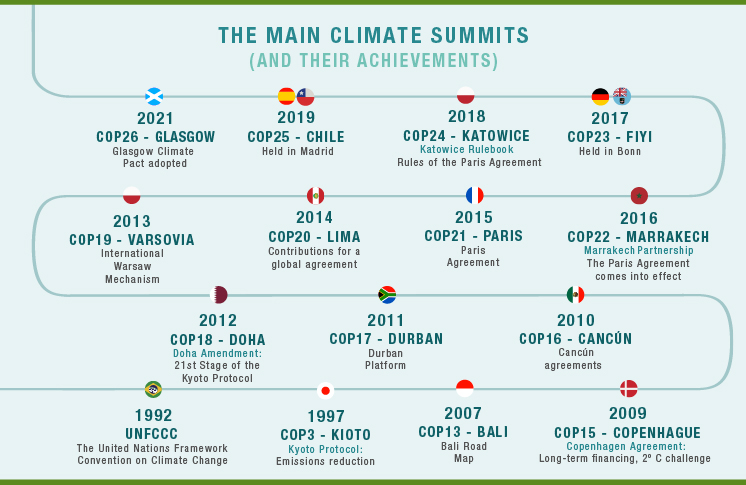What Was The Name Of The First International Agreement On Climate Change?
INTERNATIONAL AGREEMENTS ON CLIMATE CHANGE
Climate negotiations: 25 years of searching for consensus on the fight against climate change
#nature
Over the course of successive Conferences of the Parties — known equally COP — new elements accept been introduced into the international structure of the negotiations on climate change. These elements allow for specific challenges to be tackled such as mitigation financing, accommodation to climate alter, and the technological transfer.

Limiting the global temperature rise to under 2ºC compared to the pre-industrial era is one of the targets.
The United Nations Conference on Environs and Development, held in Rio de Janeiro in 1992, was a reflection of the international consensus when it came to budgeted the trouble of climatic change. During the summit, the United Nations Framework Convention on Climate change (UNFCCC) was created, which was initially signed by 166 countries and finally came into force on 21 March 1994. As of today, its has been ratified by 197 countries.
FROM THE KYOTO PROTOCOL...
The Kyoto Protocol tin can be defined as the putting into exercise of the UNFCCC. At the time, it represented the first global commitment to reigning in the emissions responsible for global warming and established the bases for subsequent international accords on climate change. Although the Protocol was signed on 16 March 1998, it did not come into effect until xvi February 2005.

The principal climate summits and their achievements.
See INFOGRAPHIC: The main climate summits and their achievements [PDF] External link, opens in new window.
As can be seen from the above graphic, since 1992 other milestones have been reached in the course of negotiations at events similar the COP (Briefing of the Parties). Beneath are the nigh pregnant agreements on climatic change:
- The setting of the target for developed countries to provide 100 billion dollars for climate finance projects in developing countries.
- The formalisation of the goal to limit the global temperature rise to below 2ºC compared to the pre-industrial era.
- The launching of the Ad Hoc Working Group on the Durban Platform and its two lines of work: Workstream one, dedicated to working towards a binding global climate agreement for the post-2020 era; and Workstream 2, dedicated to raising the level of climate ambition before 2020.
- The 2d period of commitment arising from the Kyoto Protocol runs until 2020, through what is known as the Doha Amendment (COP18).
- The launch of the Marrakesh Partnership for Global Climate Action equally a platform to involve the general public and increase their office in the process of global climate activity.
TO THE PARIS Understanding
On 12 December 2015, the text of the Paris Agreement was canonical, a legally-binding pact containing all the elements necessary to build a global strategy for the fight against climatic change for the post-2020 period — the menses prior to 2020 being covered past the second phase of the Kyoto Protocol (the Doha Amendment). Some of the primary points are summarised below:
Long-term goals
A target has been set to limit the global temperature ascent to under 2ºC by the end of the century compared to pre-industrial era levels, leaving the door open to extend this target to one.5ºC.
National contributions
It obliges all the signatory countries to present National Climate Contributions that must be regularly updated by making them increasingly ambitious so as to meet the defined long-term target.
Interchange of emissions reductions betwixt countries and indication of the price of COtwo
It includes provisions to leave the door open up both to emissions exchanges and to advances in the development of carbon pricing schemes. Under the heading of "cooperative approaches", the possibility is established of an international transfer of mitigation results (international emissions trading) and the creation of a mitigation and sustainable development machinery.
Financing
Information technology maintains the obligation on developed countries to continue to lead in providing finance, but, for the first time, "other parties" are chosen upon to requite voluntary financial support. This urges developed countries to draw up a specific road map to allow the almanac target of $100bn of climate finance to be reached by 2020.
Monitoring, reporting and verification (MRV) of the actions carried out
It includes a framework of transparency which will not be intrusive or punitive, but that must serve to create confidence amongst the various players. Information technology besides establishes that from 2023, the UN will produce a report (global stocktaking) every five years on the implementation of the agreement and the progress made — touch on of climate contributions, mobilisation of financial and technological resources, global temperature forecasts, etc.
Applied science transfer
It recognises the demand to speed up the technological transfer to developing countries and states that available technical and financial mechanisms will be used. Measures are announced to strengthen the existing mechanism which, based on the technological needs to reach an emissions path compatible with the 2ºC target, will establish the principles for incentivising it in developing countries.
Accommodation
The parties are urged to undertake adequate planning and implement measures to establish, in the instance of developing countries, the necessity for financial and technical support for its fulfilment.
Completion of the implementation of the Paris Agreement has been going on over recent years, ane of the main milestones being the approval of the Paris Agreement Rulebook (Katowice Rulebook) during the Katowice Climate Superlative (COP 24). This certificate allows, among other things, the different information and commitments to become operative and exist compared like for like; supervision over compliance with the Agreement to be established, global diagnosis methodology to exist developed; the matters of adaptation and technology transfer to be stepped upwardly; and negotiations with the aim of obtaining climate finance to be launched in the run-up to 2025.
Source: https://www.iberdrola.com/sustainability/international-agreements-on-climate-change
Posted by: gallowaydifusest.blogspot.com


0 Response to "What Was The Name Of The First International Agreement On Climate Change?"
Post a Comment